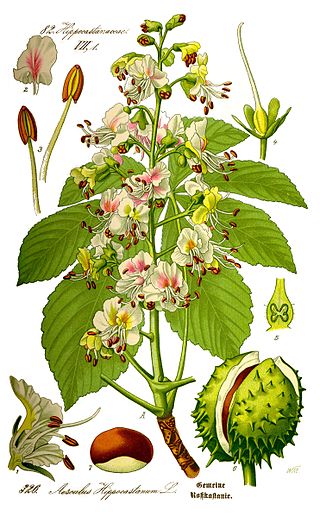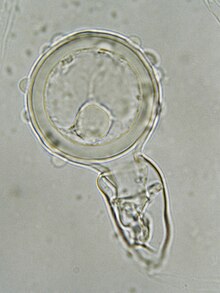
The chestnuts are the deciduous trees and shrubs in the genus Castanea, in the beech family Fagaceae. The name also refers to the edible nuts they produce. They are native to temperate regions of the Northern Hemisphere.

The American chestnut is a large, fast-growing deciduous tree of the beech family native to eastern North America. As is true of all species in the genus Castanea, the American chestnut produces burred fruit with edible nuts. The American chestnut was one of the most important forest trees throughout its range.

The pathogenic fungus Cryphonectria parasitica is a member of the Ascomycota. This necrotrophic fungus is native to East Asia and South East Asia and was introduced into Europe and North America in the early 1900s. The fungus spread rapidly and caused significant tree loss in both regions.

Castanea sativa, the sweet chestnut, Spanish chestnut or just chestnut, is a species of tree in the family Fagaceae, native to Southern Europe and Asia Minor, and widely cultivated throughout the temperate world. A substantial, long-lived deciduous tree, it produces an edible seed, the chestnut, which has been used in cooking since ancient times.

Phytophthora is a genus of plant-damaging oomycetes, whose member species are capable of causing enormous economic losses on crops worldwide, as well as environmental damage in natural ecosystems. The cell wall of Phytophthora is made up of cellulose. The genus was first described by Heinrich Anton de Bary in 1875. Approximately 210 species have been described, although 100–500 undiscovered Phytophthora species are estimated to exist.

Aesculus hippocastanum, the horse chestnut, is a species of flowering plant in the maple, soapberry and lychee family Sapindaceae. It is a large, deciduous, synoecious (hermaphroditic-flowered) tree. It is also called horse-chestnut, European horsechestnut, buckeye, and conker tree. It is not to be confused with the Spanish chestnut, Castanea sativa, which is a tree in another family, Fagaceae.

Phytophthora cinnamomi, also known as cinnamon fungus, is a soil-borne water mould that produces an infection which causes a condition in plants variously called "dieback", "root rot", or, "ink disease".

Castanea crenata, the Japanese chestnut or Korean chestnut, is a species of chestnut native to Japan and Korea. Castanea crenata exhibits resistance to Phytophthora cinnamomi, the fungal pathogen that causes ink disease in several Castanea species. The mechanism of resistance of Castanea crenata to Phytophthora cinnamomi may derive from its expression of the Cast_Gnk2-like gene.

Phytophthora cryptogea is a species of water mould in the family Pythiaceae. It is a plant pathogen that infects several species of cultivated plants, including over 40 species of cultivated flowers. It was first described as the cause of tomato foot rot in tomatoes

Lasiodiplodia theobromae is a plant pathogen with a very wide host range. It causes rotting and dieback in most species it infects. It is a common post harvest fungus disease of citrus known as stem-end rot. It is a cause of bot canker of grapevine. It also infects Biancaea sappan, a species of flowering tree also known as Sappanwood.

Phytophthora katsurae is a plant pathogen. It was first isolated from chestnut (Castanea) trees in Japan. It has also been reported from Taiwan, Papua New Guinea, Australia and Korea.

Phytophthora alni is an oomycete plant pathogen that causes lethal root and collar rot in alders. It is widespread across Europe and has recently been found in North America. This species is believed to have originated relatively recently.

Phytophthora kernoviae is a plant pathogen that mainly infects European beech and Rhododendron ponticum. It was first identified in 2003 in Cornwall, UK when scientists were surveying for the presence of Phytophthora ramorum. This made it the third new Phytophthora species to be found in the UK in a decade. It was named Phytophthora kernoviae after the ancient name for Cornwall, Kernow. It causes large stem lesions on beech and necrosis of stems and leaves of Rhododendron ponticum. It is self-fertile. It has also been isolated from Quercus robur and Liriodendron tulipifera. The original paper describing the species, stated it can infect Magnolia and Camellia species, Pieris formosa, Gevuina avellana, Michelia doltsopa and Quercus ilex. Since then many other plants have been identified as natural hosts of the pathogen. Molecular analysis has revealed that an infection on Pinus radiata, recorded in New Zealand in 1950, was caused by P. kernoviae. The pathogen was also noted on Drimys winteri, Gevuina avellana, Ilex aquifolium, Quercus ilex, Vaccinium myrtillus, Hedera helix, Podocarpus salignas.
Forest pathology is the research of both biotic and abiotic maladies affecting the health of a forest ecosystem, primarily fungal pathogens and their insect vectors. It is a subfield of forestry and plant pathology.
Bot canker of oak is a disease on stems, branches and twigs of oak trees in Europe and North America. The casual agent of Bot canker of oak is the fungus Botryosphaeria corticola. Bot canker of oak causes lesions and cankers on a wide range of oaks in Europe and most recently live oaks in North America. Some infections were formerly attributed to Botryosphaeria stevensii, but most likely represent infections by Botryosphaeria corticola. Botryosphaeria corticola is distinguishable from Botryosphaeria stevensii via ITS rDNA sequencing.

Phytophthora plurivora is a very aggressive soil-borne plant pathogen, with worldwide distribution and a wide variety of hosts.

Kauri dieback is a forest dieback disease of the native kauri trees of New Zealand that is suspected to be caused by the oomycete Phytophthora agathidicida. Symptoms can include root rot and associated rot in a collar around the base of the tree, bleeding resin, yellowing and chlorosis of the leaves followed by extensive defoliation, and finally, death.
Phytophthora pseudosyringae is a semi-papillate homothallic soil-borne plant pathogen causing root and collar rot of broadleaf tree species in Europe. It is associated with necrotic fine roots and stem necroses of Fagus sylvatica and Alnus glutinosa, and isolates are moderately aggressive to fine roots of oaks and beech (Nothofagus), highly aggressive to holly leaves and apple fruits, and slightly pathogenic to alder bark. It belongs to the class of oomycetes and is often described as a ‘fungal-like’ organism since they form a heterotrophic mycelium as the ‘true fungi’, but in contrast, their cell wall lacks chitin and is composed only of cellulose and glucans.
The Precoce Migoule is a chestnut hybrid, a natural cross between a European chestnut and a Japanese chestnut. It was discovered by J. Dufrenoy at the orchard of Migoule in Brive-la-Gaillarde. The tree is vigorous and erect growing with growth of a metre or more in a season if the conditions are right. It is a large sized chestnut tree with height reaching 20 m or more and 7.5-10 m wide. Trees start to bear after 3 to 5 years. Full nut production in 12 - 20 years depending on the location.
Gnomoniopsis castaneae is a fungus of the order Diaporthales that is the most important cause of brown chestnut rot, an emerging disease that damages the fruit of chestnuts. It also causes cankers and necrosis on leaves and on chestnut galls caused by the gall wasp, Dryocosmus kuriphilus. Additionally, it can cause cankers on other chestnut species, red oak, hazelnut trees, less severe damage to some nut trees, and lives as an endophyte on other nut trees. The disease has been reported in Europe, Oceania, and has recently been found in North America; for this reason, the fungus is considered a potential threat to the reintroduction of the American chestnut.
















